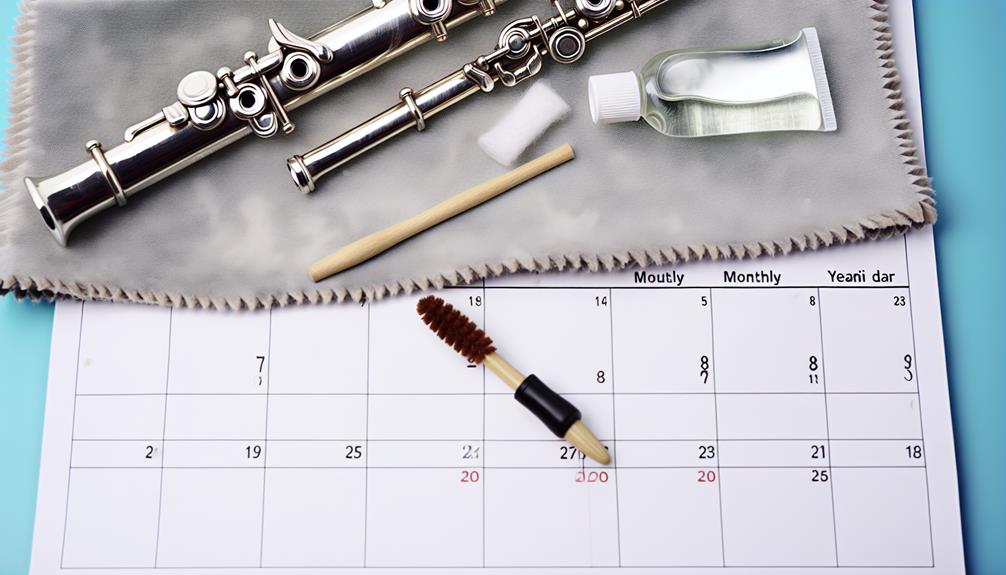Selecting the ideal music stand for flutists requires a thoughtful approach to ensure optimal performance and comfort during practice or performances. From considering height adjustment for posture to evaluating stability and portability features, each aspect plays a crucial role in enhancing your musical experience. But there's one key factor often overlooked that can make a significant difference in your setup. Stay tuned to uncover this essential element that can elevate your flute playing to new heights.
Key Takeaways
- Adjust stand to flutist's height for posture and reading comfort.
- Opt for sturdy materials and wide bases for stability.
- Evaluate portability and mobility for convenience.
- Ensure stand securely holds music sheets without bending.
- Consider collapsible designs for travel or fixed stands for stability.
Importance of Proper Height Adjustment
Ensuring the music stand is properly adjusted to the flutist's height is essential for maintaining correct posture and optimal playing conditions. The stand should be positioned at eye level when seated, allowing the flutist to read the music without straining their neck or back. Achieving the proper angle is crucial to prevent unnecessary tension in the shoulders and arms, promoting a more relaxed and comfortable playing experience.
When selecting a music stand, flutists should consider models that offer adjustable height settings to accommodate various playing environments. Some stands come with additional features such as tilting mechanisms that allow for easy customization of the angle, ensuring the music sheet is positioned for optimal visibility. Proper angle adjustment not only enhances posture but also reduces the risk of developing musculoskeletal issues over time.
Moreover, flutists should explore storage solutions provided by the music stand. Some stands offer foldable designs that make transportation and storage convenient, ideal for musicians on the go. Choosing a stand that can be easily collapsed and stored when not in use ensures the practice area remains clutter-free and organized. By considering both height adjustment and storage options, flutists can select a music stand that promotes proper playing ergonomics and fits seamlessly into their practice routine.
Consideration of Stability and Durability
For flutists seeking a music stand that meets their needs, assessing the stability and durability of the stand is paramount in ensuring a reliable and long-lasting investment. When considering stability concerns, an ergonomic design is essential to support the weight of sheet music and withstand the movements of playing the flute. Durability considerations play a significant role in the longevity of the music stand, with materials like metal or heavy-duty plastic offering robustness for frequent use.
Adjustable height is another crucial factor for flutists, allowing for customization to achieve the optimal position for reading music comfortably while maintaining good posture. Here are five key aspects to evaluate when looking at stability and durability in a music stand:
- Material Quality: Opt for stands made from sturdy materials like metal or high-quality plastic to ensure longevity.
- Base Stability: Look for stands with a wide and weighted base to prevent tipping over during performances.
- Adjustable Height Mechanism: Choose stands with a reliable height adjustment system for versatile use in different settings.
- Secure Attachment Points: Check for secure grips or clamps to hold the music sheets securely in place.
- Overall Sturdiness: Assess the stand's overall construction to ensure it can withstand regular use without wobbling or bending.
Evaluating Portability for Flutists
When considering a music stand suitable for flutists, the evaluation of portability becomes a key factor in ensuring convenience during rehearsals and performances. Flutists often need to transport their music stands to rehearsals, concerts, and lessons, making it essential to choose a stand that is easy to move and store. Let's compare different stands based on their portability and storage options in the table below:
| Stand Model | Portability Comparison | Storage Options |
|---|---|---|
| Stand A | Lightweight and compact design for easy transport | Foldable design for storage |
| Stand B | Collapsible frame with carrying bag for mobility | Removable desk for storage |
| Stand C | Adjustable height and detachable components | Carrying case included |
Portability comparison between stands A, B, and C reveals that each stand offers unique features to cater to the flutist's needs. Stand A focuses on being lightweight and compact, ideal for musicians who prioritize easy transport. Stand B provides a collapsible frame and a carrying bag, ensuring mobility and convenience. Stand C offers adjustable height and detachable components, with a carrying case included for added portability.
In terms of storage options, stand A boasts a foldable design that makes it easy to store when not in use. Stand B features a removable desk, allowing for convenient storage in tight spaces. Stand C includes a carrying case, providing a dedicated storage solution for the stand and its components. Flutists should consider these portability and storage factors when selecting the most suitable music stand for their needs.
Weight Capacity and Material Quality
With regards to music stands designed for flutists, a critical aspect to consider is the weight capacity and material quality of the stand. Ensuring that the music stand can securely hold your music sheets while remaining durable and stable is essential for a smooth performance.
Here are some key points to consider when evaluating the weight capacity and material quality of a music stand:
- Weight Capacity: The stand should be able to support multiple sheets of music without bending or wobbling, especially in outdoor or windy environments.
- Portability: While considering weight capacity, it is also important to ensure that the stand remains lightweight and easy to transport to rehearsals or performances.
- Material Quality: Opt for stands made from sturdy materials like metal or high-quality plastic to guarantee longevity and resistance to wear and tear.
- Stability: Look for stands with a solid base and adjustable height to ensure stability on different surfaces and accommodate flutists of varying heights.
- Durability: Choose a music stand that can withstand frequent use and potential knocks or bumps during transportation without compromising its functionality.
Impact of Desk Size on Performance
Considering the impact of desk size on a flutist's performance, the dimensions of the music stand's desk play a significant role in facilitating a comfortable and efficient playing experience. Performance ergonomics are greatly influenced by the space available on the stand's desk. A larger desk provides more room for sheet music, allowing musicians to easily view and turn pages without disrupting their playing flow. It also enables the placement of additional items such as a metronome or pencil for annotations, enhancing the overall practice or performance session.
Moreover, space optimization is a key factor when selecting a music stand. A desk that is too small can lead to overcrowding, making it challenging to keep sheet music organized and reducing the ease of reading. This can result in a less efficient practice session or performance, as the musician may need to spend more time adjusting the music or searching for the correct spot. On the other hand, a desk that is too large may be cumbersome and take up unnecessary space, detracting from the overall aesthetic and functionality of the stand.
Collapsible Vs. Fixed Stand Designs
In the realm of music accessories, the choice between collapsible and fixed stand designs for flutists involves careful consideration of various practical and functional aspects. When deciding between the two options, it is essential to weigh the pros and cons to ensure the most suitable stand for your needs.
- Travel friendly options: Collapsible stands are ideal for flutists who are frequently on the go, as they can be easily folded and packed into a carrying case for travel convenience.
- Adjustable stands: Opting for a stand with adjustable height and angle features provides flutists with the flexibility to customize the stand to their preferred playing position, enhancing comfort and performance.
- Sturdy construction: Fixed stands often offer more stability and durability compared to collapsible ones, ensuring that your stand can withstand regular use without compromising on reliability.
- Compact designs: For flutists with limited storage space, collapsible stands that can be neatly stored when not in use are a practical choice to keep your practice area organized.
- Portability: While collapsible stands excel in portability, fixed stands are typically heavier but can offer a more permanent setup for dedicated practice spaces.
Whether you prioritize portability, adjustability, durability, or space-saving features, understanding the differences between collapsible and fixed stand designs is crucial in selecting the most suitable option for your flute playing needs.
Cable Management Solutions for Flutists
Effective cable management is essential for flutists to maintain a clutter-free and organized practice space conducive to focused musical rehearsals. Proper cable organization not only enhances the flutist's performance by eliminating distractions but also plays a significant role in space-saving solutions and clutter reduction.
To help flutists achieve optimal cable management, the following table outlines some practical solutions:
| Cable Management Solution | Description |
|---|---|
| Velcro Cable Ties | These reusable ties are perfect for bundling and securing cables neatly, preventing tangling and tripping. |
| Cable Clips | Clips can be attached to the edge of a desk or music stand to keep cables in place and easily accessible. |
| Cable Sleeves | Sleeves are ideal for grouping multiple cables together, providing a clean look and minimizing entanglement. |
| Cable Organizers | Organizers with multiple slots keep various cables separated and organized, reducing clutter and confusion. |
| Wall-Mounted Cable Holders | These holders are great for storing cables vertically, saving floor space and keeping them off the ground. |
Lighting Options for Optimal Visibility
For flutists seeking to optimize their practice environment and ensure clear visibility while playing, selecting suitable lighting options is paramount. Proper lighting can reduce eye strain and enhance focus, ultimately improving performance.
When choosing lighting for your practice space, consider the following options:
- Adjustable Brightness: Opt for lighting fixtures that offer adjustable brightness settings to customize the intensity of the light based on your preferences and the ambient lighting conditions in your practice area.
- Flexible Positioning: Look for lighting solutions that can be easily adjusted and positioned to direct light precisely where you need it. This flexibility is especially beneficial for flutists who may need to illuminate sheet music, keys, or fingerings while playing.
- LED Lighting: Consider investing in LED lighting fixtures for their energy efficiency and bright, consistent light output. LED lights are long-lasting and often provide a more natural color temperature, which can be easier on the eyes during extended practice sessions.
- Clip-on Options: Explore clip-on lighting options that can be attached directly to your music stand or another convenient location. These compact lights are portable and can be easily repositioned as needed, offering versatility in different practice environments.
Additional Features to Enhance Comfort
Enhancing the comfort of a flutist during practice sessions can be achieved through the incorporation of ergonomic design elements in the music stand. When selecting a music stand, consider features such as adjustable angles and customizable accessories that can greatly enhance the overall playing experience.
Ergonomic design is essential for ensuring that the music stand is not only functional but also comfortable to use for extended periods. Look for stands that offer adjustable angles, allowing you to customize the height and tilt of the stand to suit your playing position. This feature can help prevent strain on your neck and shoulders, promoting better posture and reducing the risk of discomfort during practice sessions.
In addition to ergonomic design, customizable accessories can further enhance the comfort of the music stand. Consider stands that come with options for adding attachments such as extra music holders or instrument pegs to keep your flute close at hand. These accessories can help streamline your practice setup and create a more ergonomic playing environment tailored to your specific needs.
Comfortable padding is another feature to look for when choosing a music stand. Padding on the music rest and contact points where the stand meets the floor can help prevent slippage and protect your instrument from scratches. This added comfort can make a significant difference during long practice sessions, ensuring that you can focus on your music without distractions.
Budget-Friendly Options for Flutists
When considering budget-friendly options for music stands, flutists can explore practical solutions that balance affordability with quality construction and essential features. It's essential to find a music stand that suits the specific needs of a flutist while being mindful of budget constraints. Here are some key points to consider when selecting a budget-friendly music stand:
- Brand Comparison: Research different brands known for offering affordable music stands for flutists. Compare factors such as durability, stability, and portability among brands to find the best value for money.
- User Reviews: Reading user reviews can provide valuable insights into the performance and longevity of budget-friendly music stands. Look for stands with positive reviews regarding sturdiness and ease of use.
- Assembly Requirements: Consider the ease of assembly when choosing a budget-friendly music stand. Opt for stands that are simple to set up and adjust to avoid frustration during practice or performances.
- Warranty Coverage: Check if the music stand offers any warranty coverage, even within the budget-friendly category. A warranty can provide peace of mind regarding potential manufacturing defects or issues with the stand over time.
- Portability Features: Look for compact and lightweight options that are easy to transport, especially if the music stand will be used for rehearsals, gigs, or lessons outside of the home.
Frequently Asked Questions
Can a Music Stand Accommodate Sheet Music and an Ipad Simultaneously?
When considering stand compatibility for multitasking purposes, it is essential to examine whether the music stand can accommodate both sheet music and a tablet, such as an iPad, simultaneously. This integration of traditional sheet music with modern technology can enhance the musician's performance experience.
Look for music stands with adjustable features, such as additional trays or holders, to ensure seamless utilization of both physical sheet music and digital devices during practice or performances.
Are There Stands With Built-In Pegs to Hold a Flute Securely?
When considering music stands for flutists, it is essential to prioritize flute stability and security. Some stands are equipped with built-in pegs designed specifically to securely hold a flute in place during performances. This feature not only ensures the safety of the instrument but also enhances the overall convenience for the musician.
Additionally, it is beneficial to choose a stand that offers portability without compromising on flute security, providing a practical and efficient solution for flutists.
How Can I Prevent a Stand From Tipping Over During Outdoor Performances?
To prevent a music stand from tipping over during outdoor performances, consider stands with sturdy construction for wind resistance and stability. Ensure proper weight distribution by placing heavier items on the base.
Opt for stands with rubber feet or anti-slip grips for better ground grip. Additionally, using sandbags or weights can further anchor the stand. These precautions help mitigate the risk of tipping over in outdoor settings.
Do Any Stands Offer Adjustable Tilt Angles for Different Playing Positions?
When considering stand stability and portability options, it's crucial to look for music stands that offer adjustable tilt angles for different playing positions. This feature allows flutists to customize the stand to their preferred angle, enhancing comfort and performance.
Adjustable tilt angles also contribute to better posture and reduce strain during extended practice or performance sessions. Prioritizing this functionality can greatly benefit flutists seeking a versatile and ergonomic music stand.
Are There Stands With Extra Storage Compartments for Accessories Like Tuners or Metronomes?
Some music stands provide stand organization through additional storage compartments that cater to accessories like tuners or metronomes. This feature enhances stand versatility by offering dual functionality, allowing musicians to keep essential items within reach during practice or performances.
Accessory compartments contribute to a more organized and efficient playing environment, ensuring that musicians have all necessary tools readily available without the need for separate storage solutions.
Conclusion
In conclusion, choosing the right music stand for flutists requires careful consideration of several factors:
- Height adjustment
- Stability
- Portability
- Material quality
- Desk size
- Cable management
- Lighting options
- Additional features for comfort
By prioritizing these factors, flutists can enhance their performance and prevent tension in their shoulders and arms.
Stay tuned for our next article on tips for maintaining your music stand to ensure long-lasting use and optimal functionality.




